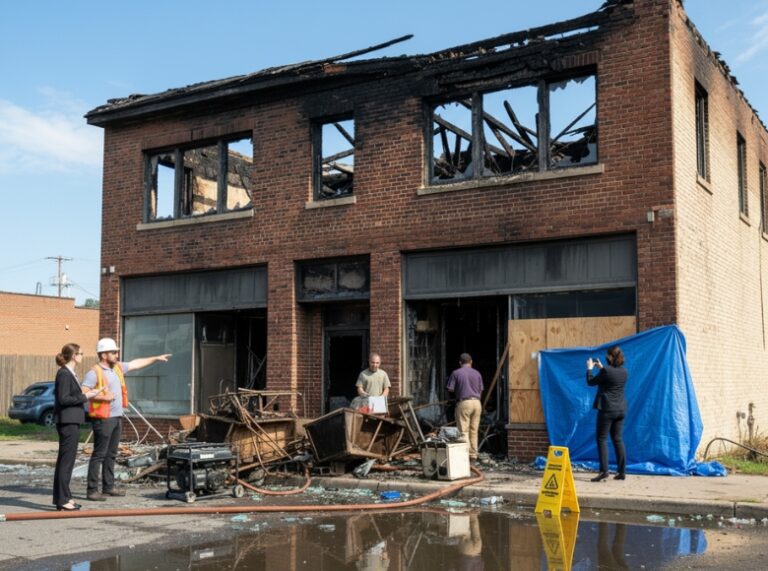Fires often leave behind more than visible destruction. The emotional toll, confusion, and pressure to act quickly can cause property owners to make decisions that impact their ability to recover fully. Among the chaos, the wrong steps taken after fire damage can delay insurance claims, lower settlements, or even cause outright denials.
In commercial and industrial losses, these mistakes often multiply. When fire disrupts business operations, time becomes critical. Understanding what commonly goes wrong after a fire can help prevent costly consequences and pave the way toward faster and fairer claim recovery.
Why Immediate Actions Matter After Fire Damage
Every decision made in the first few hours after fire damage shapes how well a property owner recovers later. Once the fire is extinguished, most people rush to start cleaning or moving damaged materials. While that instinct seems practical, acting without professional guidance can destroy valuable evidence that insurance adjusters rely on to assess damage.
Insurance companies require complete documentation before approving any claim. If evidence disappears or gets altered, insurers may question the validity of losses. Simple actions such as discarding damaged items, starting repairs too soon, or failing to photograph every affected area often weaken the foundation of the claim.
Early documentation is critical. Photographs, video recordings, and written notes should capture the condition of every affected area before any cleanup begins. Even soot patterns or water marks can hold essential clues to assess the extent of fire and smoke exposure. When this step gets overlooked, it becomes much harder to prove how severe the damage truly was.
The Risk of Poor Communication with Insurers
After fire damage, property owners sometimes delay contacting their insurance carriers or fail to notify them in the proper format. This mistake can trigger disputes later, especially when policy language requires immediate notification.
In many large-scale losses, property owners also underestimate the complexity of insurance communication. Insurers may request additional documents, proof of ownership, or cost breakdowns that require consistent and timely responses. When deadlines get missed or responses remain incomplete, claims often move slower or become undervalued.
Accurate records of all conversations, emails, and reports help maintain transparency throughout the process. Having a structured communication trail prevents misunderstandings and ensures that the policyholder’s position remains supported by facts, not assumptions.
Overlooking Hidden and Secondary Damage
Fire rarely causes damage in isolation. Even when flames spare certain areas, smoke, heat, and water from firefighting efforts can spread harm throughout the structure. One of the most common mistakes after fire damage is failing to identify these secondary effects early on.
Smoke residue can corrode metals, stain surfaces, and infiltrate ventilation systems. Water used to suppress flames often leads to mold growth, warping, and electrical system failures if left untreated. These indirect damages may not appear immediately but can create significant repair costs later.
Comprehensive inspection by qualified professionals helps uncover what the eye might miss. Industrial fires especially demand deeper evaluation since machinery, wiring, and structural integrity can suffer internal damage invisible during initial assessments.
Mismanaging Documentation and Inventory
In the aftermath of fire damage, stress and urgency often lead property owners to compile incomplete or inaccurate records. Missing purchase receipts, vague descriptions, or incomplete inventories can drastically reduce claim value.
A detailed inventory list that includes item descriptions, quantities, conditions, and approximate values becomes a vital tool in the insurance process. Photographic or video evidence attached to each entry strengthens the proof of ownership and loss extent.
Without organized documentation, insurers have the upper hand in valuing the claim. A missing invoice or unclear description can result in lower reimbursement or outright rejection of certain items. In large commercial losses, this can translate into millions in unrealized recovery.
Fire Damage Documentation Checklist: Do’s and Don’ts After Fire Damage
After fire damage, the first few steps play a decisive role in how smoothly the insurance process unfolds. Following a structured checklist helps protect both evidence and claim value.
Do’s:
- Document Everything Immediately: Take clear photographs and videos of every affected area before moving or discarding anything.
- Create a Detailed Inventory: List damaged items with descriptions, quantities, and approximate values. Include receipts or appraisals when possible.
- Secure the Property: Prevent further deterioration by covering openings, boarding up windows, and ensuring safety around the structure.
- Keep All Communication Records: Maintain a log of every interaction with the insurer, contractors, and inspectors for reference.
- Consult Professionals: Engage fire restoration experts and public adjusters early to ensure all damage, including hidden or secondary issues, gets properly recorded.
Don’ts:
- Do Not Start Major Repairs Prematurely: Wait until insurance representatives and adjusters complete their inspections.
- Avoid Disposing of Damaged Property: Items may serve as vital evidence to prove the extent of loss.
- Don’t Rush Through Cleanup: Improper cleaning can erase key signs of fire and smoke damage.
- Never Assume Coverage Without Verification: Review the insurance policy carefully or consult a professional before approving restoration contracts.
- Avoid Delaying Claim Reporting: Prompt communication with the insurer ensures faster assessment and claim processing.
Taking these steps minimizes the risk of disputes, delays, and undervaluation. When every detail of fire damage is well-documented, it strengthens the entire foundation of the insurance claim and accelerates fair settlement.
Starting Repairs Without Approval
Another frequent mistake involves beginning reconstruction or cleanup before the insurance company completes its evaluation. Although the intention is to speed up recovery, this often violates policy conditions and complicates the claims process.
Once repairs start, insurers may argue that essential evidence has been removed or altered, leading to disputes over the claim’s legitimacy. Before any permanent restoration begins, written authorization from the insurer should confirm that damage assessment is complete.
Temporary repairs such as covering exposed roofs or securing entrances are acceptable to prevent further deterioration. However, full-scale restoration should always wait for proper documentation and agreement from all parties involved.
Ignoring Professional Representation
Insurance claims for fire damage often exceed ordinary experience. Policies contain complex language, coverage exclusions, and conditions that most property owners find difficult to interpret. Attempting to manage large-loss claims without professional help frequently leads to underpayment or procedural errors.
Public adjusters and damage assessment specialists bring in-depth understanding of policy structures and valuation methods. Their early involvement ensures that every aspect of the loss from structural damage to business interruption is properly documented and presented. When professionals take charge early, property owners can focus on business continuity instead of battling documentation or negotiation issues.
How Accurate Evaluation Ensures Fair Compensation
Each fire damage case carries its own financial and structural complexity. The true cost of loss extends beyond physical repairs; it includes operational downtime, lost inventory, and business disruption. Only accurate evaluation can represent these elements in the claim file.
Detailed reports, third-party inspections, and forensic accounting support ensure that insurers recognize every legitimate expense. This accuracy prevents undervaluation and enables smoother negotiation. The earlier these steps begin, the higher the chances of securing fair settlement without extended disputes or appeal processes.
The Long-Term Impact of Delayed Actions
Many property owners believe that once insurance coverage activates, recovery is guaranteed. In reality, delays or errors in initial actions can influence every stage of the claim. Failure to meet documentation deadlines, late communication, or incomplete records can lead to prolonged claim cycles.
Over time, financial strain intensifies as repair costs accumulate, and business operations remain disrupted. Proactive planning, early documentation, and professional oversight significantly reduce these risks. Timely coordination between inspection teams, contractors, and adjusters keeps the claim on track toward resolution.
Conclusion
Recovering from fire damage requires more than rebuilding structures; it demands strategic, well-documented action from the very start. Every choice from how evidence is collected to when repairs begin shapes the financial and operational outcome of the claim.
Avoiding common mistakes after a fire can make the difference between full recovery and financial shortfall. Proper communication, detailed documentation, and professional guidance remain the pillars of a successful claim. As insurance processes grow more complex, careful preparation becomes the key to restoring both property and stability with accuracy and confidence.
Professional Support for Fire Damage Claims
In complex commercial and industrial losses, public adjusting services play a critical role in managing the aftermath of fire damage. Such teams handle claim preparation, evidence documentation, damage assessment, valuation, and negotiation directly with insurance carriers. Their technical expertise ensures that every element of loss; structural, mechanical, or operational is correctly identified and justified within the policy scope.
With decades of large-loss claim experience across multiple industries and regions, Continental Adjusters represents policyholders through every stage of claim recovery. From site inspection to final settlement, the firm delivers proven strategies to achieve maximum recovery while maintaining complete transparency with all involved parties.
Operating across more than 40 states and internationally, Continental Adjusters continues to be a trusted name in handling large, complex property losses arising from fire and other catastrophic events.
Contact Continental Adjusters today to discuss large-loss recovery solutions and ensure accurate, timely, and fair compensation for all commercial fire-related claims.
FAQs
How do I avoid making my fire damage worse?
After a fire, avoid entering unstable areas or attempting major cleanup without professional guidance. Do not throw away damaged items, as they may serve as evidence for insurance claims. Secure the property temporarily to prevent further damage, such as covering openings or removing water accumulation. Document everything with photos and notes before any permanent repairs begin.
What common mistakes do property owners make with insurance claims?
Many property owners delay reporting the loss or fail to communicate properly with their insurer. Others begin repairs too soon, discard damaged items, or maintain incomplete documentation of their losses. These mistakes can lead to lower settlements, disputed claims, or outright denials. Early professional guidance helps prevent these errors and ensures claims are fully supported.
What’s the first thing I should do after fire damage?
The first step is to ensure personal safety and evacuate the affected area if necessary. Notify the insurance company promptly and begin documenting damage with photos and written notes. Avoid making permanent repairs until a professional assessment is complete. Contacting a public adjuster early can help secure evidence and guide the claim process efficiently.



